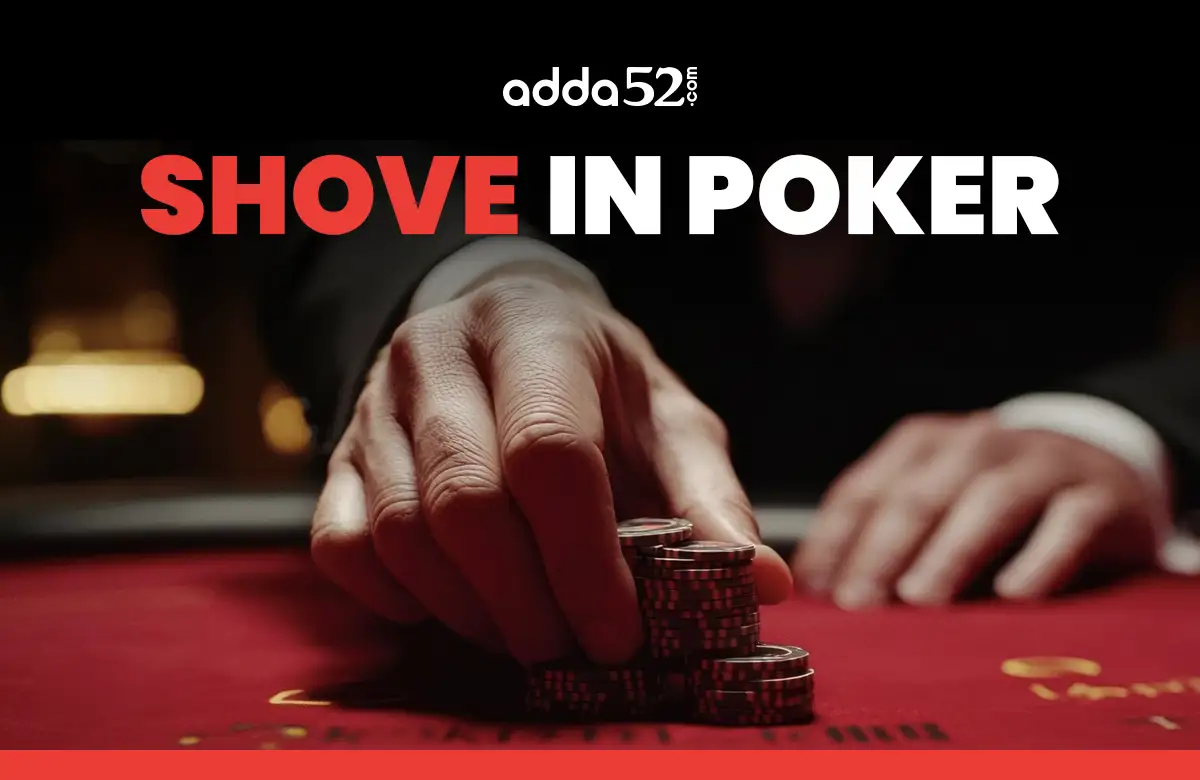
Introduction
A Poker shove is one of the most aggressive moves in the game. It can happen at any stage of the hand—pre-flop, post-flop, or on the river. Mastering when and how to push in poker is a key skill that sets experienced players apart from casual ones.
Here, we will provide an in-depth explanation of shoving in Poker.
Understanding Poker Shove
A shove is the act of pushing all of a player’s chips into the pot in one go, effectively committing to the hand. The term ‘shove’ is commonly used in poker tournaments but can also apply in cash games.
When Do Players Shove?
Shoves can be used in various scenarios, and knowing when to shove is as important as knowing how to shove.
Preflop Poker Shoves:
- Short-Stack Situations: Shoving preflop is the most efficient strategy when a player has a small stack, usually 10 big blinds or fewer. By shoving, they maximize fold equity, giving themselves a chance to win the blinds and antes without going to a showdown.
Example: A shove is often your best move if you are holding A♠ K♣ with 8 big blinds and are under the gun (early position).
- Late Position: In a tournament or cash game, shoving from the late position (the cutoff or button) with strong hands like A♦ 10♠ or medium pairs (e.g., 10♠ 10♣) can pressure the players in the blinds to fold weaker hands.
Example: You have 9♣ 9♠ in the cutoff with 15 big blinds. A shove here forces the players in the blinds to make tough decisions.
Postflop Shoves:
- Strong Hands: A post-flop shove can be a powerful strategy when you have hit a strong hand, such as a straight, flush, or full house, and want to maximize your opponents' value.
Example: You hold 8♦ 9♦ and the board shows 7♠ 10♦ J♣. Shoving with a straight (and the potential for a flush) is a solid way to capitalize on the strength of your hand.
- Drawing Hands: Sometimes, players shove with a flush or straight draw when the pot is large, or the situation is favourable, hoping to force folds or get value if they hit their draw.
Example: With 6♠ 7♠ and a board reading 10♠ 2♠ 3♣, you have a flush draw. A shove can pressure opponents holding top pairs, making them more likely to fold.
Bluff Shoves:
A bluff shove is a calculated play in which you push all your chips into the pot without having a strong hand, hoping your opponent folds. This is more common in tournament play, especially near the bubble, where players hesitate to risk their stacks.
Example: You are on the button with J♠ 10♠, and the board shows Q♠ 8♠ 2♣. You don’t have much, but a shove might force opponents with second or third pairs to fold.
Shoving as a Defense:
Shoving can also be a defensive strategy, especially against opponents applying constant pressure. This move can stop an aggressive opponent from bullying you or force them to fold, securing the pot.
Example: In a heads-up situation where your opponent has been consistently raising, you might shove with a hand like K♠ Q♣ if you think they are likely to fold most of their weaker hands.
Shove Poker Strategies
-
Stack Size and Pot Odds:
Your decision to shove should depend heavily on the size of your stack and the pot odds you are getting. If your stack is too large, shoving may not make sense unless you have a strong hand. However, if you have a small stack, shoving is often your best move to avoid being blinded.
Short Stacks: In tournament Poker, players with stacks of 10 big blinds or fewer typically have no choice but to shove with a wide range of hands in certain spots, maximizing fold equity. With a large stack, however, you can afford to play a more strategic game and avoid unnecessary risks.
Pot Odds: If you have an open-ended straight or flush draw and are receiving favourable pot odds, you may choose to shove for maximum pressure or to gain value if you hit your draw.
-
Table Position:
Position is one of the most important factors when deciding whether to shove. Players in early positions face fewer opponents yet to act, making it riskier to shove with marginal hands. Conversely, being in a late position provides more insight into the actions of other players, giving you a clearer sense of whether your shove is likely to succeed.
-
Opponent Types:
Understanding your opponents' tendencies is essential when determining whether to shove. Tight players tend to fold to a shove, while loose players may call with weaker hands.
Tight Players: If you are up against a tight player who only plays premium hands, your shove will likely force them to fold. This allows you to take down the pot with weaker hands.
Loose Players: Loose players call with a wider range of hands, so you need to adjust your strategy accordingly. Against these players, a shove may need to be made with stronger hands to ensure you’re not risking your stack with a weak hand.
Shove Techniques
-
Shoving and Re-Shoving:
In multi-player pots, especially in tournament play, shoving and re-shoving can create dynamic situations. A re-shove occurs when someone pushes a Poker player, and that player with an even smaller stack decides to shove over the original bet.
Example: You have a 12 big blind stack and hold A♠ 10♣ in early position. A player with a 10 big blind stack Poker shoved, and you decide to re-shove with your A♠ 10♣, applying pressure to the original player. If you have a read on their range and believe they will fold weaker hands, a re-shove can be a powerful play.
-
Understanding the ‘Shove Fold’ Chart:
Shove fold charts, commonly used in tournament play, outline the ranges of hands that are optimal for shoving based on stack size, position, and the actions of your opponents. These charts are a quick guide to making mathematically sound decisions, but experienced players will also adjust these ranges based on the situation in the specific tournament.
Shoving in Cash Games vs. Tournaments
While the concept of shoving remains the same in both cash games and tournaments, the frequency and motivation behind shoving differ:
In Tournaments:
- Blinds and Antes: The growing blinds and antes force players to commit more frequently, especially when their stack is small.
- Tournament Pressure: The threat of elimination creates more urgency and increases the value of shoving, especially when you are down to low stacks.
In Cash Games:
- No Increasing Blinds: Shoves are less frequent since there are no escalating blinds in cash games. Players can reload their stacks, which makes calling a shove less costly.
- Value Shoves: Shoving in cash games is typically reserved for strong hands or as part of a larger strategy to bluff or mislead opponents into folding.
Frequently Asked Questions
What is shoving?
A shove involves betting all your chips at once or going ‘all-in’. This move can occur before the flop, after the flop, or on the river. A player shoves Poker chips to pressure their opponents, gather more chips, or prompt tough decisions from other players. Shoving is especially common in tournament settings where chip stacks are typically smaller, and every decision counts significantly.
When should you shove in Poker?
Shoving is ideal when you have a short stack, around 10 big blinds or less, or a strong position, such as holding a premium hand. It’s also effective as a bluff, especially in a late position or when trying to take down the blinds and antes.
What is the best hand to shove?
The best hands to shove include premium hands like A♠ A♦, K♠ K♦, and Q♠ Q♦. Depending on your stack size and position, hands like A♠ K♣, 10♠ 10♣, or suited connectors like J♠ 10♠ are often strong shoves in tournament situations.
Conclusion
The Poker shove is a bold and aggressive move that can reshape the course of a hand. When executed properly, this high-risk strategy offers you an edge in both cash games and tournaments. By perfecting your skill to choose the right moments for shoving, you can keep opponents off balance and elevate your game overall.
